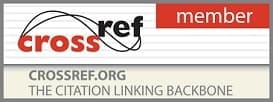
Printed Journal | Refereed Journal | Peer Reviewed Journal
Peer Reviewed Journal
International Journal of Horticulture and Food Science
Instructions to Author
Submit Manuscript: Manuscripts can be submitted via email attachment to hortijournal@gmail.com or through Online Submission.
Click the following links to download the Copyright Agreement and Authorship Responsibility form:
Manuscript Submission: The manuscript must be submitted with a covering letter from the corresponding author to the Managing Editor via email at hortijournal@gmail.com. Upon successful submission, the corresponding author will receive an acknowledgment within one week. Any queries regarding the preparation and submission of a manuscript should be addressed via the "Contact Us" page. English is the official language of the journal. Only original research articles that have not been previously published or are not under consideration for publication elsewhere should be submitted.
Corresponding authors must confirm that the manuscript is submitted on behalf of all authors. Copyright for the manuscript will belong to the publisher upon acceptance. Submission of a manuscript signifies acceptance of the journal's guidelines for authors.
Manuscript Presentation: The article should clearly describe new and thoroughly confirmed results, along with the experimental procedures, in sufficient detail to allow others to verify the work. The manuscript should be prepared in English using "MS Word." The "Times New Roman" font should be used. Manuscripts must be typed double-spaced with one-inch (2.5 cm) margins on all sides. All pages should be numbered starting from the title page. Lines should be numbered in the margins, with continuous numbering from the start of the manuscript.
The font size should be 12 pt, with main headings in 14 pt and subheadings in 12 pt (bold). All research articles should include the following sections: Title page, Abstract, Keywords, Introduction, Materials and Methods, Results, Discussion, Conclusion, Acknowledgments (if any), and References. The sections in the text should be subdivided as 1, 1.1, 2, 2.1, 2.1.2, etc. Authors may optionally provide at least three potential reviewers from the same research field (not from the host institute), including their full addresses, email IDs, and mobile numbers.
Title: The title should be followed by the author names and their institutional affiliations, with superscripts indicating each affiliation. The title page should contain the title in boldface, title case, and the authors' names in normal font, upper case (font size 12), followed by their institutional addresses in normal font, lower case. An asterisk (*) should be placed after the corresponding author's name, with the corresponding author's email, fax, and telephone numbers provided. The corresponding author is responsible for ensuring that all co-authors are aware of and approve the contents of the submitted manuscript.
Abstract: This section should summarize the problems, experimental approach, major findings, and conclusion in a single paragraph. Avoid abbreviations, diagrams, and references in the abstract. It should be single-spaced and should not exceed 150 words for full papers.
Keywords: Authors should provide 4-6 keywords that identify the most important topics covered by the paper. These should be placed at the end of the abstract.
Introduction: The manuscript should include a brief introduction that states the purpose of the investigation and relates it to similar previous research. Only essential information relevant to the arguments should be presented.
Materials and Methods: This section must include specific details about the materials studied, instruments used, chemicals, and related experimental details, allowing other researchers to reproduce the results. Obtain permission for all borrowed, adapted, or modified tables, and provide a credit line in the footnote.
Results and Discussion: The results should be presented concisely. Results and discussion may be separate or combined, based on the author's preference. Tables and figures should be designed to maximize the clarity of the experimental data. The interpreted results should be explained clearly in the discussion and related to existing knowledge in the field as clearly as possible. Tables, graphs, and figures (illustrations) should be inserted at the respective places in the text where they should appear when published. They should be numbered appropriately and have explanatory headings. Labels on tables, graphs, and figures must be in text form and should not form part of the image. These photographs must be clear and sharp, and digital files are recommended for the highest quality reproduction.
Conclusion: The author should summarize the findings and provide a clear conclusion.
Acknowledgments (if any): This section can be placed at the end of the manuscript, before the reference section. It can be used to acknowledge the help of individuals who do not qualify for authorship, as well as to recognize funding, donated resources, or significant contributions to the research.
References: References to the literature cited in the manuscript should be numbered in order of appearance in the text and cited in the manuscript with superscript numbers. The reference format is as follows:
For Journals: Author(s) (surname, initials). Title of the manuscript. Journal title (abbreviated). Year of publication; volume number (issue number): page numbers.
Example: Panda BB, Gaur K, Kori ML, Tyagi LK, Nema RK, Sharma CS et al. Anti-inflammatory and analgesic activity of Jatropha gossypifolia in experimental animal models. Global Journal of Pharmacology. 2009; 3(1):1-5.
For Books and Other Monographs: Author AB, Author BB, Author CC. Title of Book. Ed, Vol, Publisher, City, Year, page numbers.
Example: Nadkarni KM. Indian Materia Medica. Edn 3, Vol. I, Popular Prakashan, Mumbai, 2000, 242-246.
For Patent References: Aviv H, Friedman D, Vered K. Submicron emulsions as ocular drug delivery vehicles. U.S. Patent 5496811; 1996.
For Website References: Habitat utilization pattern by winter migrants at Kolleru Lake in Andhra Pradesh. Available at: https://www.biospace.com. Accessed May 27, 2007.
Fees Details:
There is no article 'submission fee' in the Journal. But, as the Journal is not receiving any governmental &/or non-governmental financial add, the authors are required to pay an article 'handling / processing fee'. This fee contributes to the costs involved in Indexing, Formatting, Publication process and Web development.
Indian Authors: 2500 INR (w.e.f. 01.01.2025)
International Authors: 55 USD (w.e.f. 01.01.2025)
Submit Manuscript at: hortijournal@gmail.com
Related Journal Subscription
Related Links
Important Links








